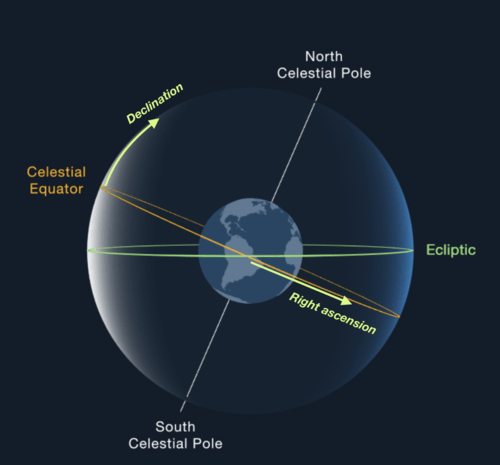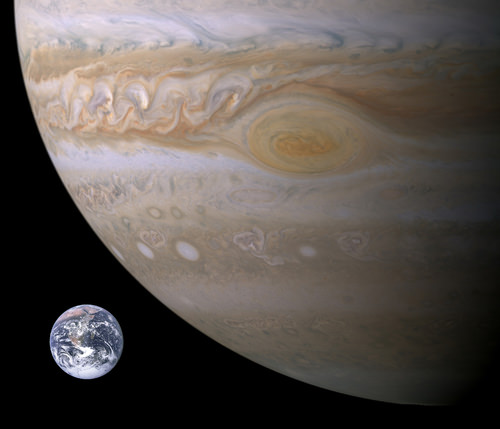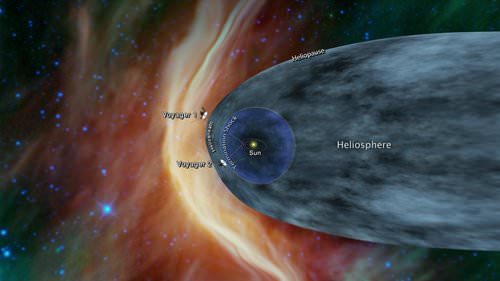1.1 我们在空间中的地位
章节大纲
-
Our Place in Space
::我们在太空中的位置In 2016, Pete Kostelnick ran across the country from New York to San Francisco, a distance that is one tenth the circumference of the Earth. It took him 46 days, 6 hours, and 30 minutes. From the perspective of humans, the Earth is a pretty big place. However, as planets go, the Earth is small. It is worth taking a step back and reflecting on how our home planet fits into the big picture of the solar system, the galaxy, and the universe. This perspective is valuable as we consider the possibility of life elsewhere.
::2016年,彼得·科斯泰尼克从纽约横跨整个国家到旧金山,距离是地球环绕的十分之一。他花了46天、6小时和30分钟的时间。从人类的角度来看,地球是一个相当大的地方。然而,随着行星的迁移,地球是很小的。值得退后一步,思考我们的地球如何适应太阳系、银河系和宇宙的大图景。这个观点很有价值,因为我们考虑到其他地方的生命可能性。The scale of the solar system
::太阳系的规模We use rulers to measure the sizes of objects on our desks and miles or kilometers to measure distances to other cities. Clearly, it would not make sense to use inches to describe the distance between New York and San Francisco. Likewise, when we think about objects like planets and stars, the units of miles or kilometers are too small. We need a different measuring stick. The ideal metric will match our intuition or experience with the physical world. Some of the common ``measuring sticks'' that astronomers use are:
::我们用标尺测量办公桌和里程或公里上物体的大小,以测量与其他城市的距离。 显然,使用英寸来描述纽约和旧金山之间的距离是没有意义的。 同样,当我们想到行星和恒星等物体时,英里或公里的单位太小。 我们需要不同的测量棒。 理想的测量标准将匹配我们的直觉或经验与物理世界。 天文学家使用的一些常见的“ 测量棒” 是:-
Astronomical units
(AU)
- the distance between the Earth and the Sun - this is handy for comparing distances to planets within our solar system. One AU is 1.49 x 10
8
km, or 93 million miles. It takes light about 8 minutes to travel 1 AU.
::天文学单位(AU)——地球和太阳之间的距离——用来比较太阳系内行星的距离。一个AU是149x108公里,或9 300万英里。它需要8分钟的光来旅行一个AU。 -
Light years
(ly) - the distance that light travels in one year (note that this is not a measure of time, it is a measure of distance). This unit is handy for describing distances to stars within our galaxy. When we see the light from a star that is 40 light years away, we are seeing light that left that star 40 years ago. One light year is
km or 63,240 AU.
::光年( ly) 光年 -- -- 光在一年中行走的距离( 注意这不是时间的量度, 而是距离的量度 ) 。 这个单位对于描述银河系内恒星的距离十分方便。 当我们看到40光年之外的恒星发出的光时, 我们可以看到40年前离开恒星的光。 一个光年是9.5×1012公里或63, 240AU。 -
Parsecs
(pc) - formally, this is the distance at which the orbital radius of the Earth (1 AU) subtends one arcsecond (or 1/3600 of a degree). Using parsecs as a metric for distance greatly simplifies our calculations for distances to stars that are measured with trigonometric parallaxes. One parsec also equals 3.26 light years or 206265 AU. We use parsecs for describing distances to stars in the Milky Way galaxy, and kiloparsecs (kpc = 1000 pc) or megaparsecs (Mpc = 1 million pc) for describing distances to other galaxies.
::剖析( pc) - 正式地说, 这是地球轨道半径(1 AU) 以一弧秒( 或一个度的1/ 3600) 潜伏的距离。 使用剖析值作为距离的测量尺度, 大大简化了我们对使用三角光谱测量的恒星距离的计算。 一个剖析值也等于 3. 26 光年或 206 265 AU 。 我们使用剖析值来描述银河系中恒星的距离, 以及千帕塞克( kpc = 1000 pc) 或千帕塞克( Mpc = 100万 pc) 用于描述与其他星系的距离 。
However, astronomers have the flexibility to use any handy, scale-appropriate metric. The mass or radius of a planet can be arbitrarily described in Earth units. The mass, radius, and luminosity of other stars are usually given in solar units (i.e., relative to the Sun).
::然而,天文学家可以灵活地使用任何方便的、适合规模的测量尺度。一个行星的质量或半径可以用地球单位任意描述。其他恒星的质量、半径和光度通常用太阳单位(即相对于太阳)表示。Consider the scale of the solar system. How does the size of the Earth compare to the size of Jupiter? Or to the size of the Sun? How many Astronomical Units (AUs) from the Sun to Jupiter? What are these distances like in terms of light travel times? How long does it take a photon to travel from the Sun to the Earth?
::考虑太阳系的大小。 地球的大小与木星的大小相比如何? 还是与太阳的大小比较? 从太阳到木星的天文单位(AUs)有多少? 这些距离与光旅行时间相似吗? 光从太阳到地球需要光子多久?The video below gives a great overview of the scale of the solar system.
::下面的录像很好地概述了太阳系的规模。What are your three take-away points from this video?
::你从这段视频中 有三个起飞点是什么?Where is the halfway point (spatially) between the Sun and Neptune? How does the spacing of the inner rocky planets compare to the spacing of the outer gas giants? Why might the gas giant planets be farther away from the Sun than rocky planets like Earth?
::太阳和海王星之间的中间点(间距)在哪里?内岩行星的间距如何与外气巨星的间距相比?为什么气体巨行星比地球这样的岩石行星离太阳更远?( Film by Alex Gorosh and Wylie Overstreet. )
:影片由Alex Gorosh和Wylie Overstreet拍摄)
Pointing to the stars
::指向星星Astronomers use an Earth-centric coordinate system for viewing other stars. This coordinate system was inherited from the ancient (and incorrect) belief that the Earth was motionless and that everything else - the planets, stars and the Sun - revolved around the Earth. With this perspective, the sky and stars appeared to be printed onto the celestial sphere, an imaginary bubble encircling the Earth. The precise locations of objects on the celestial sphere are specified by the celestial equivalent of latitude and longitude.
::天文学家使用以地球为中心的坐标系统来观察其他恒星。 这个坐标系统是从古代(不正确)的信念中继承的,即地球是无动的,所有其他行星、恒星和太阳都围绕地球旋转。从这个角度看,天空和恒星似乎被印在天体上,一个虚构的泡泡环绕地球。天体上物体的确切位置由纬度和经度等同的天体确定。Some reference points are relative to the observer, that is, the point directly overhead for the observer. The horizon is the great circle where the sky "touches" the Earth, and this will also be observer-centric. The meridian is an arc that runs between the celestial poles (the projection of the Earth's north and south poles) and the zenith. The meridian is also defined relative to the observer.
::某些参考点与观察者相对, 即观察者直接上方的点。 地平线是天空“ 触摸” 地球的大圆圈, 也以观察者为中心 。 中间线是天体极( 地球的北极和南极的投影) 和天顶之间的弧形。 中间线也是相对于观察者的定义 。However, there are absolute positions that do not depend on the location of the observer. As shown in the below, the equator of the Earth is projected into space as the "celestial" equator, and a second great circle, the "ecliptic" defines the orbital plane of the Earth. Because the spin axis of the Earth is tilted with respect to the orbital plane, the celestial equator is tilted relative to the ecliptic.
::然而,有些绝对位置并不取决于观察者的位置。如下文所示,地球赤道被投射到空间中,作为“天体”赤道,第二个大圆,“黄页形”定义地球的轨道平面。由于地球的旋转轴相对于轨道平面倾斜,天体赤道相对于黄页形倾斜。The celestial coordinate system projects the coordinates of Earth into space. Declination is equivalent to latitude on Earth and right ascension is like longitude. Space is 3-dimensional, so why are two coordinates adequate for locating celestial objects?
::天体坐标系统将地球的坐标投射到空间。 分解相当于地球的纬度, 右升像经度。 空间是三维, 那么为什么两个坐标足以定位天体呢 ?Declination is the celestial equivalent of latitude on the Earth. It ranges from 0 to 90 degrees from the celestial equator to the celestial poles. Declination is positive north of the celestial equator and negative south of the celestial equator.
::断层是地球纬度的天体等同物,从天体赤道到天体极介于0至90度之间,天体赤道以北为正值,天体赤道以南为负值。Right ascension is the celestial equivalent of longitude. The zero point for right ascension is at the the intersection of the ecliptic and the celestial equator that defines the vernal equinox and the beginning of spring. This is the time of the year when the Sun is directly above the equator at noon. Right ascension ranges between 0 and 360 degrees around the celestial pole. Since the Earth rotates once every 24 hours, the sky appears to turn by 15 degrees every hour and the part of the sky that is visible is constantly changing.
::右升空是经度的天体等同。 右升空的零点是在极光和天体赤道的交叉点上, 它定义了春初和春分。 这是太阳在正午直接在赤道上空的一年中的时间。 右升空范围在天体极周围的 0 至 360 度之间。 由于地球每24小时旋转一次, 天空似乎每小时旋转15 度, 可见的天空部分正在不断变化 。Memorizing numbers?
::记住数字?There is no need to memorize charts of numbers, but it is worth remembering the ``round number'' distances to a few planets in our solar system in terms of Astronomical Units.
::没有必要背弃数字图表,但值得记住的是,从天文单位的角度来看,太阳系中几颗行星与几颗行星的距离是圆数。-
Mercury is 0.4 AU from the Sun (you will learn that many of the exoplanets that have been discovered orbit much closer than 0.4 AU to their host stars).
::水银是太阳的0.4AU(你会知道,许多被发现的外行星的轨道远比其主星的0.4AU高出0.4AU) 。 -
Jupiter is another solar system landmark at 5 AU.
::木星是5AU的又一个太阳系里程碑。 -
The light travel time from the Sun to the Earth is 8 minutes and the light travel time to other planets just scales with their distances. So, it takes about 40 minutes for a photon of light to travel from the Sun to Jupiter.
::从太阳到地球的轻型旅行时间是8分钟,光向其他行星的飞行时间只是以距离为尺度。因此,光从太阳到木星需要大约40分钟,光从太阳到木星需要大约40分钟。 -
The edge of our solar system? It's about 120 AU from the Sun (about 3 times farther than the distance to Pluto). Amazingly, the
space probes, which
were
launched in 1977, have
.
::我们太阳系的边缘?大约120个来自太阳的AU(距离冥王星的距离约3倍)。令人惊讶的是,1977年发射的太空探测器已经发射。
Other handy numbers for the solar system:
::太阳系的其他可用数字:-
Jupiter is about 300 times the mass of the Earth
::木星是地球质量的300倍左右 -
The Sun is 1000 times the mass of Jupiter
::太阳是木星质量的1000倍 -
The
is about 11 times the radius of Earth, but 1/10
th
the radius of the Sun.
::大约是地球半径的11倍, 但太阳半径的1/10。
NASA provides a handy fact sheet listing information about solar system planets in or .
::美国航天局提供了一份简便的概况介绍,其中列出了太阳系行星在或太阳系中的有关信息。Comparison of the size of Earth and Jupiter. Earth is about the same size as the Great Red Spot on Jupiter. The diameter of Jupiter is about 11 times the diameter of Earth.
::比较地球和木星的大小。 地球与木星上的大红点大致相同, 木星直径约为地球直径的11倍。The Voyager Mission
::旅行旅行团In 1965, calculations showed that a "once in 175 year" event was about to occur : Jupiter, Saturn, Uranus, and Neptune would line up in such a way that a spacecraft could use the gravitational energy of each planet in turn to swing on to the next planet. In 1972, the Voyager mission was approved to travel to the outer solar system. On August 20, 1977, the slower Voyager II mission was launched before the faster Voyager I mission, which was launched on September 5, 1977. The Voyagers were powered by Plutonium-238 (radioactive half life of 88 years), which produced 470 W to run all of the instruments.
::1965年,计算显示“175年中发生一次”事件即将发生:木星、土星、天王星和海王星会排成一列,这样航天器就可以使用每个行星的引力能量,转而飞向下一个行星。1972年,旅行者飞行任务获准前往外太阳系。1977年8月20日,航行者二号飞行任务在1977年9月5日发射的越快越慢的越快的越快越好飞行任务之前发射。Voyagers的动力来自Plutonium-238(放射性半衰期为88年 ) , 产生470 W 运行所有仪器。Voyager I flew by Jupiter, then continued on to Saturn before taking a trajectory above the ecliptic plane of the solar system planets. Voyager II used gravitational slingshots to travel from Jupiter to Saturn to Uranus and to Neptune before turning below the ecliptic plane.
::我从木星飞过,然后继续飞向土星,然后在太阳系行星的日光平面上空沿轨飞行。 沃杰二号使用引力弹弓从木星飞到土星到天王星和海王星,然后转到日光平面下方。The scientific discoveries from the Voyager spacecraft were stunning. Voyager I took the first image of the Earth and the moon in a single frame. Thousands of images of Jupiter were spliced together to make a movie showing the movement of storms in the atmospheres of Jupiter and Neptune. Shortly before Voyager 1 returned images of Jupiter's closest moon, Io, physicist Stanton Peale (University of California, Santa Barbara) and colleagues had published a theoretical paper predicting that tidal energy between Jupiter and Io would cause the surface of Io to be volcanically active. Peale and his colleagues were rewarded in just a few days with the first close-up images of Io, confirming their prediction. The Voyager mission returned our first detailed images of the rings of Saturn, showing that they were comprised of icy material that is shepherded by many small Saturnian moons. Images from Voyager II showed that Jupiter, Uranus, and Neptune have tenuous rings, and many additional moons were discovered around these giant planets.
::旅行者航天器的科学发现是惊人的。 旅行者我用一个框架拍摄了地球和月球的第一幅图像。 木星的数千幅图像被拼凑在一起拍摄一部电影, 展示木星和海王星大气层中的风暴运动。 在旅行者1号归还木星最接近的月球的图像之前不久, 旅行者1号归还了木星的图像, Io, 物理学家Stanton Peale(加利福尼亚大学,圣芭芭拉)和同事发表了一份理论文件, 预测木星和木卫一之间的潮汐能会引发木星表面的火山活动。 Peale及其同事在短短几天内就收到了木卫一和木卫一的第一幅近的图像, 证实了他们的预测。 旅行者任务归还了我们关于土星环的第一张详细图像, 表明这些图像是由许多小土星月的牧羊的岩体组成。 沃雅人二号的图像显示木星、 天王星和海王星有脆弱的环, 在这些巨行星周围还发现了更多的卫星。In addition to the rich scientific discoveries, the Voyager spacecraft also have important lessons for humanity. At a distance of 4 billion miles from the Earth, just before Voyager 1 left the solar system, Carl Sagan convinced the engineers at NASA to turn the space craft around and take a picture of the home planet. Earth appears as a pale blue dot. Upon seeing this image, Sagan wrote: "Look again at that dot. That's here. That's us. On it, everyone you love, everyone you know, everyone you ever heard of, every human being who ever was lived out their lives on this mote of dust, suspended in a sunbeam."
::除了丰富的科学发现外,旅行者航天器对于人类也有重要的教训。在距离地球40亿英里的距离,就在旅行者1号离开太阳系之前,卡尔·萨根说服美国航天局的工程师们把太空飞船转过身去,拍下一颗地球的照片。地球看上去像一个苍白的蓝色点。看到这幅图时,萨根写道 : “ 再看看那个点,这就是这里。这就是我们。在它上面,你爱的每个人,你知道的每一个人,你所听说过的每一个人, 每一个曾经生活在这块尘土上的人, 都生活在这块尘土上,在太阳光束中悬浮着。”The Pale Blue Dot: an image of Earth, a speck in the bright streak of scattered light, taken by Voyager I as it was leaving the solar system.
::灰蓝点:地球的图象,是分散光线闪耀的一丝斑点,由旅行者一号在离开太阳系时拍摄。The spacecraft have both left the solar system and are now traveling in the space between the stars, the "interstellar medium." In 2012, Voyager 1 passed through the heliopause - a bubble around the Sun and planets dominated by the solar wind, and Voyager 2 began passing through this boundary in 2018. The spacecraft are traveling at a speed of about 35,000 miles per hour, and as of 2019, they are still beaming a weak signal back to the Earth. Because of the enormous distance, the received power of their electric chirp is about 2 Watts.
::航天器已经离开了太阳系,现在正在星体之间的空间中行驶,即“星际介质 ” 。 2012年,旅行者1号穿过了太阳层——太阳周围的泡泡和太阳风主宰的行星,旅行者2号于2018年开始穿过这个边界。航天器以每小时35 000英里的速度飞行,截至2019年,它们仍然在向地球发出一个微弱的信号。由于距离太远,它们的电铃声接收到的能量约为2瓦特。The position of Voyager 1 and 2 space probes circa 2018 is shown relative to the heliopause, a boundary where the magnetic field of the Sun no longer deflects cosmic rays from the galaxy. What are the most distant planets in our solar system? Where does the heliopause reside with respect to these planets?
::1号和2号太空探测器的位置显示在2018年星座上,与日光圈相对,太阳磁场不再将宇宙射线从银河系转移开来。太阳系中最遥远的行星是什么?这些行星的日光圈住在哪里?The most unique component on the Voyager probes is a time capsule of information inscribed into a gold record. A stylus for playing the record and the turning frequency are provided. Information on the record gives details about our location. The recorded information describes our biochemical make-up, including and the nucleotide bases in our DNA, and provides iconic cultural images, circa 1977. In addition to greetings in more than 50 languages, the Voyagers are carrying , including the haunting " " by Blind Willie Johnson and Chuck Berry's " ." A 1977 Saturday Night Live skit portrays extraterrestrials finding the recording and sending back the message: "Send more Chuck Berry."
::旅行者探测器中最独特的部件是将信息输入黄金记录的时间胶囊。 提供了用于播放记录和回转频率的图案。 记录中的信息详细介绍了我们的位置。 记录中的信息描述了我们的生化构成, 包括我们的DNA中的核糖酸基, 并提供了标志性文化图像, circa 1977 。 除了用50多种语言问候外, Voygers还携带着“ ” , 包括盲人Willie Johnson和Chuck Berry的“ ” 。 1977年星期六的夜间滑雪队描绘了外星人寻找录音并发送信息:“ 发送更多Chuck Berry ” 。The Voyager spacecraft are now destined to orbit the center of the galaxy, like all of the stars in the Milky Way. They may well live outlive our Sun and our solar system. Perhaps in the very distant future, another civilization will intercept these spacecraft. If they decode our message, they will know that once upon a time in the galaxy, there was another civilization with the generosity to send a message: "You are not alone. Here is the code for carbon-based life that lived on our planet. Even if our species is never able to learn if we are alone in the vast universe, we hope that this message will give you some answers."
::旅行者航天器现在注定要绕着银河系的中心轨道运行,就像银河系中的所有恒星一样。它们可能活得比太阳和太阳系还久。也许在非常遥远的将来,另一个文明会拦截这些航天器。如果它们解码了我们的信息,它们就会知道,在银河系中,有另一个文明慷慨地发出一个信息:“你不是孤单的。这是我们星球上以碳为基础的生命的代码。即使我们的物种永远无法知道,如果我们在广阔的宇宙中是孤独的,我们希望这个信息能给你们一些答案。” -
Astronomical units
(AU)
- the distance between the Earth and the Sun - this is handy for comparing distances to planets within our solar system. One AU is 1.49 x 10
8
km, or 93 million miles. It takes light about 8 minutes to travel 1 AU.



